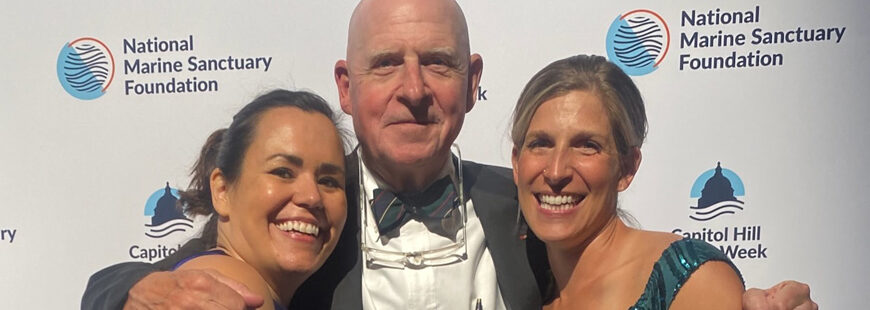Join us August 24th for a Waterside Chat featuring the proposed Heart of the Ocean (Alaĝum Kanuux) marine sanctuary in the waters off Alaska. Host Tom Sadler will speak with guests Marissa Merculieff, director of the Office of Justice and Governance Administration for the Aleut Community of Saint Paul Island, host Tom Sadler, and Lauren Divine, director of the Ecosystem Conservation Office for the Tribal Government of Saint Paul Island (all three featured in the fortuitous photo above). Register now to learn more about:
- The conservation and cultural significance of the Alaĝum Kanuux sanctuary
- The vital species the area supports
- A historic co-management agreement to establish co-equal governance and decision making for the sanctuary
The Marine Fish Conservation Network’s Waterside Chat series connects people who depend on healthy oceans and fisheries with the issues that directly affect them and their communities. Each episode the Network’s Deputy Director Tom Sadler talks with different guests about ocean policy and fisheries management topics. He engages them in genuine and thoughtful conversations about what policy decisions mean for people’s livelihoods, communities, recreation, and coastal ways of life. You can Watch past Waterside Chats on our website, and please join our email list to learn about future episodes.
More about Heart of the Ocean
From the nomination proposal: “We are Unangax̂. The Pribilof Islands of Tanax̂ Amix̂ among the most unique and important places in the world. To us, the marine waters surrounding our islands are alaĝu kanuux̂, heart of the ocean.”
From NOAA’s Federal Register Notice of Alaĝum Kanuux: “The Aleut Community of St. Paul Island Tribal Government nominated the area for consideration as a national marine sanctuary to protect nationally significant biological and cultural resources in the area. The area’s ecosystem supports globally significant populations of marine mammals, seabirds, and fish, including various ecological and cultural keystone species such as northern fur seals and Steller sea lions. The oceanographic features of the area results in a highly productive zone that supports representative biogeographic assemblages of biodiversity and maintenance of critical habitat for foraging and for important life stages of many threatened and endangered species, as well as species considered to be keystone, foundation, or focal.”



PRESS RELEASE
On August 21, 2022, an Open Letter to French parliamentarians was published on the subject of a Bill: “accelerating renewable energies”.
Accelerating the development of renewable energies on land and at sea means taking unconsidered risks of negative effects and impacts;
– First, on the terrestrial and oceanic environment,
– Then, on the food resources essential to the survival of the French people,
– Finally, on the evolution of the physical and mental health of the population.
Our analysis shows, among other things, that electromagnetic field losses from power transmission cables facilitate the bioaccumulation of metals in animals and humans.
With regard to offshore wind farm projects, an increasing number of scientific publications warn of the serious consequences of the loss of electromagnetic fields on the embryogenesis and survival of species of molluscs, crustaceans and fish. – These studies do not take into account aggravating factors, including the essential one, metal bioaccumulations under the influence of electromagnetic losses from the cables.
The argument of a “reef effect” and a “habitat effect” favorable to marine fauna, or even an “overflow effect” advantageous for professional fishing, which may even justify the creation of a network of Marine Protected Areas prohibited from sampling is illusionism.
Indeed, it is precisely these first two “effects” that will intensify contamination.
– On land, plants and animals accumulate metals, including rare earth elements, under the influence of losses of electromagnetic fields (CEM) from electricity transmission cables. All the more so with the poorly stabilized wind energy that the Anglo-Saxons call “waste” energy.
– At sea, the oceanic trophic chains will be contaminated at several levels, including that of many species of diatoms which are known for their bioaccumulative capacities, species essential to the sequestration of CO² and the production of photosynthetic oxygen.
On land and at sea, the trophic chains will be gradually contaminated by a bioaccumulation of metals, including natural and “anthropogenic” rare earths due to the bioaccumulative capacities of the electromagnetic fields lost by the cables. – Land and ocean food resources will become toxic. Logically, these chronic metallic bioaccumulations and the weakening of biological detoxification systems and the “blood-brain barrier”, under the influence of electromagnetic fields and their interactions, metallic resonances and amplifications and with graphene, will result, ultimately, to neurological damage by cerebral bioaccumulation of metals, as it is essential to definitively verify in farm animals. A bill : “for the acceleration of renewable energies” is dangerous; against the land and ocean environment, against the food resources essential to the survival of the French people and against the physical and then mental health of the population. The communication officer of Atelier Anonymus,
chrystophe grellier